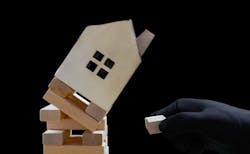Rising Mortgage Rates Sink Homebuyer Demand
Mortgage demand to buy or refinance a home is at its lowest level since 1997 as interest rates continue to climb, a sharp contrast to the early months of the pandemic, when low interest rates caused mortgage demand to surge amid a nationwide homebuying frenzy. As 30-year fixed-rate mortgages with conforming loan balances reach their highest level since 2002, the share of borrowers who benefit from refinancing is at a record low.
As prospective homebuyers struggle to keep up with rising housing costs, many are now turning to risker adjustable-rate mortgages (ARMs) to secure lower rates. The ARM share last week rose to 12.8% of total mortgage applications, the highest share posted since March 2008.
“The speed and level to which rates have climbed this year have greatly reduced refinance activity and exacerbated existing affordability challenges in the purchase market,” Joel Kan, an MBA economist, said in a release Wednesday. “Residential housing activity ranging from new housing starts to home sales have been on downward trends coinciding with the rise in rates.”
